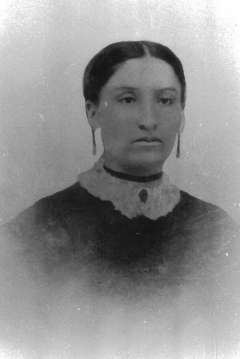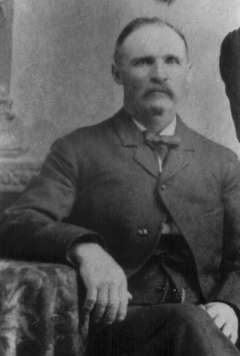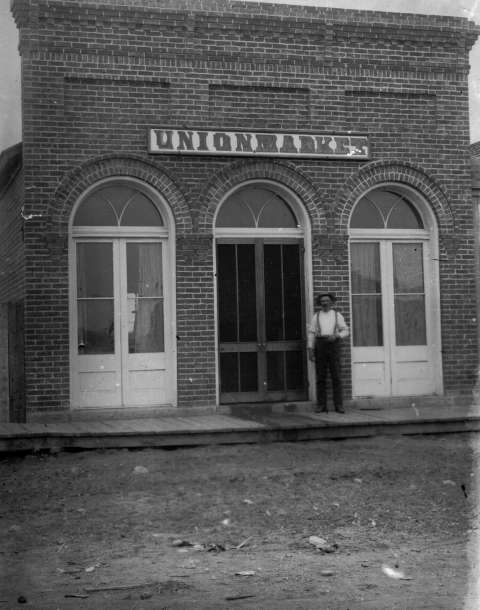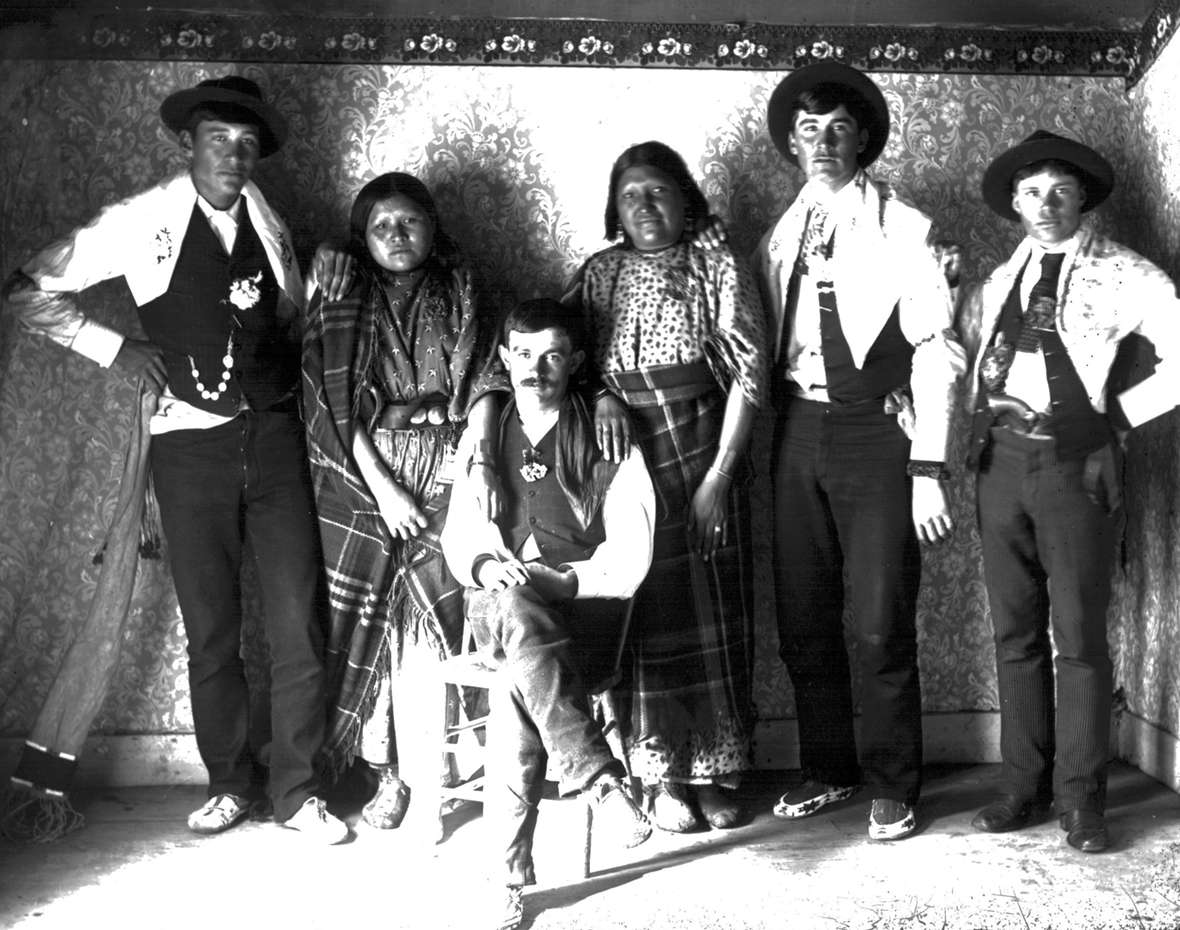- Home
- Encyclopedia
- Three Mixed-race Families and a Wagon Train Att...
Three Mixed-race Families and a Wagon Train Attack: A Story of Frontier Survival
Bullets splintered the wagon box. Arrows shredded the wagon’s canvas cover. Two pregnant women huddled together in the wagon, trying to make their toddlers lie down. The travelers in this 12-wagon train, circled against their Lakota Sioux attackers, were outnumbered 20 to one and losing fast.


|
Then, from the meager protection of the wagons, one of the women, eight months pregnant and impeded by her bulk, strode out into the midst of the battle. She had recognized some of the attackers—she knew them personally. She shouted at the Indians to stop their attack or her brother, their own Hunkpapa Sioux war chief, Gall, would take vengeance.
Woman Dress Lamoreaux and her relatives
At the time of the attack, the travelers were near Split Rock on the Oregon Trail, about a day’s travel west of Devil’s Gate in what’s now central Wyoming.
How did one of their attackers’ own people, Woman Dress Lamoreaux, come to be in this wagon train on the way from Fort Laramie to the South Pass area in March and April 1868? It was an atypical group: Of the 26-member party, about half were American Indians, mixed-bloods or white men who had married Indians.
In the early and mid-1800s, many white traders—often French-speaking, with roots in French Canada or the Mississippi Valley—married Cheyenne, Sioux and Shoshone women, gaining important business alliances by these unions. At least three such extended families were traveling in this wagon train.
The most prosperous member of the wagon train was Fort Laramie trader Jules Lamoreaux; five of the 12 wagons were his. Lamoreaux was born in Canada at Hyacinthe, Quebec, in 1836. He worked at Fort Laramie for James Bordeaux before opening his own store there, marrying Woman Dress in 1862. At the time of the 1868 journey to South Pass, they had two children, Lizzie and Richard, ages about 5 and 3.
The Lajeunesses
The largest group was the clan of Charles Lajeunesse, also known as Seminoe, who operated a trading post at Devil’s Gate from 1852 to 1856, and at other times and points along the Oregon Trail. Lajeunesse's grown, half-Shoshone sons, Mich, Noel and Ed, were escorting their pregnant younger sister, Louisa Lajeunesse Boyd, along with her husband, William Henry Harrison Boyd, and their daughter, Martha, approximately 3 years old. Boyd was from Tennessee and had come west in about 1859 where he worked for and was educated by Charles Lajeunesse, eventually becoming his partner, and marrying his daughter about 1864.
Mich and Noel had fought at the July 1865 Battle of Platte Bridge near present Casper, Wyo., where Mich killed High Backed Wolf, a Cheyenne chief. High Backed Wolf had killed their father a few weeks previously, and Louisa and the other Shoshone women at Platte Bridge celebrated this revenge by dancing and singing, wearing High Backed Wolf's scalp-decorated, bloodstained shirt.
The Ecoffeys
Yet another mixed-blood couple, Julia Bissonette Ecoffey, a half-Sioux, and her husband Frank Ecoffey, were also with this expedition. Julia's father, Joseph Bissonette, was a trader, government interpreter and partner of Charles Lajeunesse and William Boyd on Deer Creek about 1864. Bissonette had been in the trading business along the trails at least since 1842, when he had accompanied the explorer John C. Fremont as an interpreter from Fort Laramie to Red Buttes near present Casper. Ecoffey, a French-Swiss, arrived at Fort Laramie in 1855, clerking for Bissonette and Lajeunesse in the early 1860s. In 1865, about two years before he married Julia, he had a store at Platte Bridge and helped defend it during the battle that July.
Survival in a fast-changing world
All of these mixed-blood families had been established at Fort Laramie before deciding to move to the area of South Pass, planning to set up business near the soon-to-be-booming gold camps where significant finds had been made in 1867. Once-profitable trade with Indians and with white emigrants was waning.

The Union Pacific Railroad, building west, spawned towns and stores filled with cheap manufactured goods that cut into the traders' business. As buffalo herds dwindled, many Indians had become impoverished and were settling on the reservations, or were increasingly hostile—especially the Sioux and Cheyenne—as they chose to defend their lands. These were the years of Red Cloud’s War along the Bozeman Trail to the northeast, and of many raids and skirmishes along the Oregon and Overland trails across what’s now Wyoming.
Along with vanishing economic opportunities, mixed-race people faced a decline in their social status. At the peak of trading between whites and Indians, mixed-bloods connected the two cultures, facilitating commerce and political ties.
But more and more white newcomers despised the white men who married Indians as "squaw men" and their children as mongrels; their children belonged wholly to neither one world nor the other. These people had limited options: They could settle on a reservation, continue the losing battle for the American West alongside their full-blood Indian relatives or assimilate into white culture.
The attack on the 1868 wagon train exacerbated the uneasy situation of these mixed-blood people, so it was perhaps all the more remarkable that a full-blood Indian woman stopped it. The Lakota Sioux ceased firing and called to Woman Dress that they would talk to her if the men of the wagon train also stopped shooting. The Indians became cowed and respectful, escorting the wagon train farther along the trail before dispersing to warn off other bands of marauding Sioux.
Into the 20th century
At the end of their 300-mile, six-week journey from Fort Laramie, the Lamoreaux, Lajeunesse, Boyd and Ecoffey families camped in willows where the Oregon Trail crossed Willow Creek, a few miles east of South Pass City. The night they arrived, April 25, 1868, Woman Dress Lamoreaux gave birth to her son, named Willow.
Mich and Noel Lajeunesse, having escorted their sister Louisa and her family to their destination, returned by prior plan to Fort Laramie and their own wives and children. They lived for the rest of their lives in the Platte Valley near Fort Fetterman, on the river about 50 miles east of Platte Bridge. Their brother Ed worked as a teamster near the South Pass mines.
The Lamoreaux, Lajeunesse and Ecoffey families settled for a time in Atlantic City, four miles north of South Pass City, where feeling against Native people was high in the wake of Sioux and Arapaho attacks on the South Pass miners. Eventually they all moved to the new town of Lander, successfully integrating themselves into white culture there.
Frank Ecoffey, one of the founding fathers of Lander, became the U.S. Army beef contractor for Camp Stambaugh and Fort Brown (later Fort Washakie). Eventually he and his family moved to the Pine Ridge reservation for Sioux in South Dakota to join Julia's people.
Jules Lamoreaux was elected the second mayor of Lander, and Woman Dress, in the midst of bearing and raising their 17 children, worked to improve the town. She was so respected that when she died in 1908, at about 63, Lander businesses closed in her honor. Their eldest, Lizzie, was voted the most popular girl in Lander five years after Crazy Horse and the ferocious Gall, her uncle, defeated Custer at the Little Bighorn in 1876. Lizzie married Ed Farlow, a local cowboy, and became president of the Pioneer Association, which built and operated the Pioneer Museum, now at 1443 Main Street in Lander. In 1913, Lizzie and Ed’s mixed-blood son, Stub, was photographed riding a bucking bronc, and this image was at least one of the models for the well-known Wyoming cowboy design on automobile license plates.
Will and Louisa Lajeunesse Boyd were legally married on Feb. 15, 1873, in Atlantic City, thus conforming to the mores of white culture. Will established a large ranch and also operated a business on Main Street in Lander. The Boyds built a house in Lander and hosted the town's first interdenominational Sunday school there. Nine of their children survived infancy, and in 1908 their son Will, Jr., traveled to Washington, D.C., as part of an official Shoshone/Arapaho delegation to defend tribal property against the U.S. government. Other Boyd children became active in tribal politics. Louisa who, in her late teens, had danced in High Backed Wolf's bloody shirt, was honored as the oldest Wind River valley pioneer before she died in 1927, at approximately age 79.
Thus, these three prominent mixed-blood families gained acceptance by their dual cultures and became leaders for both; a fitting conclusion to a dangerous journey of a small wagon train, rescued by a courageous Sioux woman.

Resources
- Guenther, Todd. "Pioneers Extraordinaire: A Most Unusual Wagon Train," Overland Journal, 18:4, (Winter 2000-2001): 3-17. Guenther's sources for the account include books, letters, manuscripts, oral histories, memoirs, and journal and newspaper articles. Guenther teaches history, anthropology and museum studies at Central Wyoming College in Riverton, Wyo., and serves on the advisory board for WyoHistory.org.
- Rea, Tom. Devil’s Gate: Owning the Land, Owning the Story. Norman, Okla.: University of Oklahoma Press, 2006, pp. 39, 64-77, 100.
Illustrations
- All photos are from the collections of the Lander Pioneer Museum. Used with permission and thanks.
